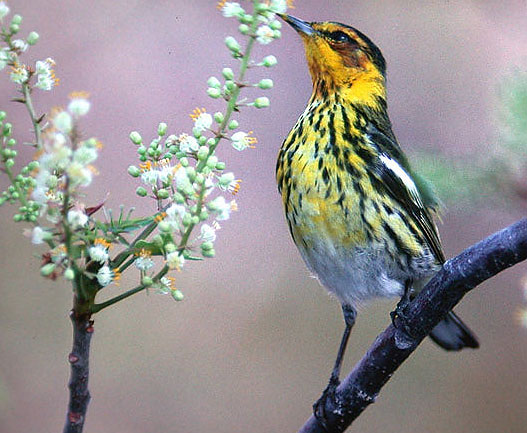- Dendroica tigrina
Description
A small New World warbler.
Breeding Male
- Brown back
- Yellowish rump
- Dark brown crown
- Yellow underparts
- Heavily streaked black on lower throat, chest and flanks
- Blackish wings and tail edged olive
- White tail spots
- White vent and undertail coverts
- Bright yellow throat and nape
- Chestnut auricular patch
- Black eyestripe
- Narrow white wing bar
- Sharply pointed bill
Female and Immature
- Washed out versions of breeding male
- Lack strong head pattern
- Yellowish rump
- Weak white wing bars always present
Distribution
Breeds in Canada from northeastern British Columbia, southern Northwest Territories and northern and central Saskatchewan east to eastern Quebec, [[New Brunswick, and Nova Scotia; in the United States in northern Minnesota, northern Michigan, northern Vermont, northern New Hampshire, most of Maine, and in a very small area in the Adirondacks of New York. It is migratory, wintering in the West Indies. Rare to casual vagrant to Alaska and the western United States. Accidental vagrant to Great Britain.
Habitat
The breeding habitat is the edges of coniferous woodland, especially Black Spruce.
Behavior
Usually sings from high perches.
Nesting
Cape May Warblers nest in dense foliage near the trunk of a conifer, laying 4-9 eggs in a cup nest.
Diet
Insectivorous, and lay larger clutches in years when Spruce Budworm is abundant. They pick insects from the tips of conifer branches or fly out to catch insects in flight. They also feed on berry juice and nectar in winter, and have, uniquely for a warbler, a tubular tongue to facilitate this.
Voice
Song
Very high and thin; may sound slightly buzzy; four to seven unslurred notes (5/second) seet seet seet seet seet or slightly lower-pitched, faster, more complex seeo seeo seeo seeo seeo or witse witse witse wit
Call
A very high, hard, short te, or a thin sip.
Flight call a very high, slightly buzzy tzew or tzee slightly descending.




